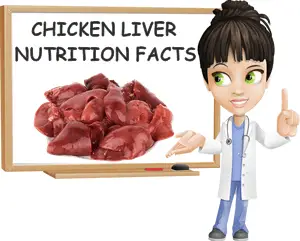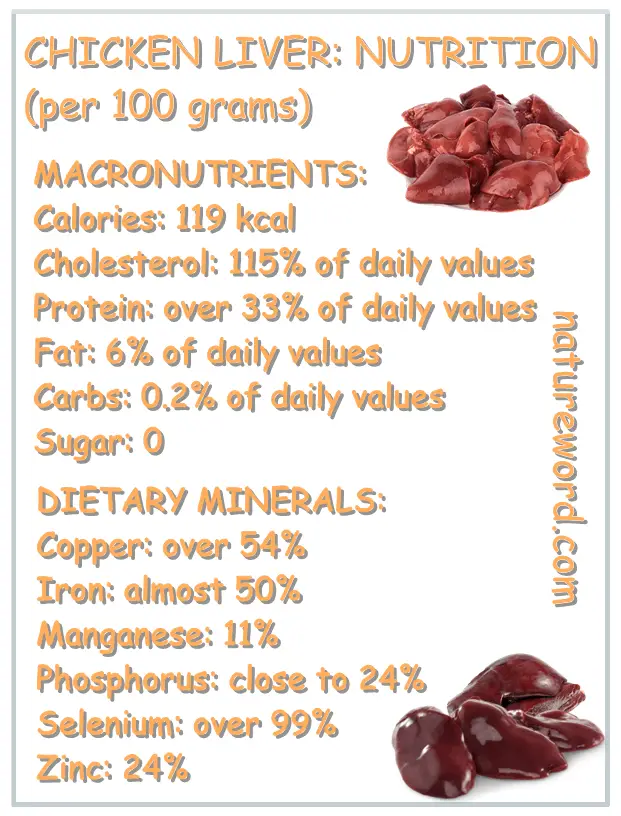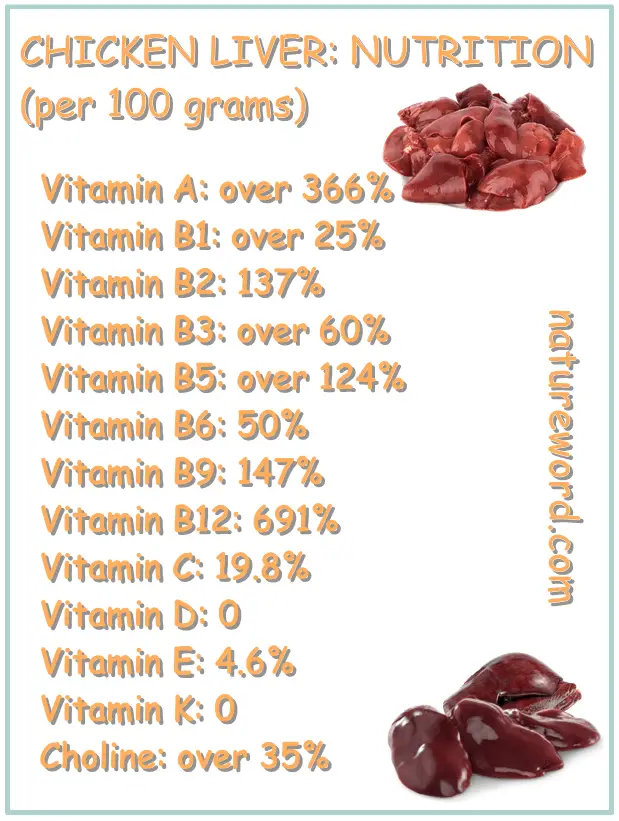Ever wondered what is the nutritional value of liver? How much of your daily vitamins and minerals do you get from eating liver? What about the protein content of liver? Are there any carbs in liver? Is liver high fat? How many calories in liver? How healthy is liver based on its nutritional value?
Today we’re going to break down the nutrition of chicken liver. Why chicken? Chicken liver is readily available and an accessible food price-wise. Not just this, but it’s one of the more tolerable liver options due to its somewhat milder flavor so the best one to start with. Read on to find out what vitamins and minerals are in chicken liver, how much protein and fat and how many carbs. Discover how much of your daily nutrition you get from eating just 100 grams of chicken liver.

Chicken liver (raw): nutritional value per 100 grams
How many calories in chicken liver?
There are 119 kilocalories (kcal, calories) in 100 grams of raw chicken liver. While liver is quite a dense food, meaning 100 grams of chicken liver won’t look like much food on your plate, it’s not a food high in calories either. On the contrary, chicken liver, and other varieties, can be successfully incorporated into a weight loss diet in small amounts and contribute to maintaining elevated energy levels whilst supporting nutritional status.
How much cholesterol in chicken liver?
Cholesterol is one nutrient everybody is interested in. There are 345 mg (milligrams) of cholesterol in 100 grams of raw chicken liver. The average adult can have 300 mg of cholesterol a day, but even if they go above the recommended amount some days, that won’t be a factor that breaks their health. On the contrary, cholesterol is good for you.
Cholesterol qualifies as a nutrient because it is a source of nutrition and benefits for health. For example, cholesterol helps build the protective myelin sheath coating surrounding the tail of nerve cells.
Degradation of the myelin sheath exposes neurons and causes electrical impulses to not be transmitted as effectively, resulting in a less effective communication between the body and the brain.
Loss of the myelin sheath is also a marker of degenerative diseases of the nervous system such as multiple sclerosis. So don’t villainize cholesterol and don’t fear it either because it is actually healthy when eaten in reasonable amounts.

How much protein in chicken liver?
There are 16.9 grams of protein in 100 grams of raw chicken liver. How much protein a day? The average adult is advised to consume 50 grams of protein every day. This means that a serving of 100 grams of raw chicken liver provides 33.8% of the entire daily recommended protein intake for the average adult.
Not just this, but the protein from chicken liver is high quality, complete in all essential amino acids. Amino acids are what proteins are made of and essential amino acids are amino acids the body cannot make on its own, but needs to get every single day. Amino acids are important for the brain and nervous system and help regulate mood, appetite and sleep, among other benefits.
Discover more benefits of eating liver.
How much fat in chicken liver?
There are only 4.8 grams of fat in 100 grams of raw chicken liver which actually makes it a low-fat food among animal foods and plant foods too. Walnuts, for example, have over 65 grams of fat per 100 grams.
The average adult can eat up to 78 grams of fat a day and 100 grams of chicken liver would account for a little over 6% of the total recommended intake. To keep it low-fat, eat chicken liver boiled, steamed or baked liver instead of fried.
According to its fat profile, chicken liver provides small amounts of the following fatty acids:
- Linoleic acid, a polyunsaturated Omega-6 fatty acid also found in olive oil, coconut oil, lard and egg yolk.
- Alpha-linolenic acid (ALA), a polyunsaturated Omega-3 fatty acid also found in chia seeds, flax seeds, purslane, kiwifruit seeds, walnuts and sea buckthorn and sea buckthorn seed oil.
- Gamma-Linolenic acid, a polyunsaturated Omega-6 fatty acid also found in durian, oats, barley and hemp seeds, meat and oils.
- Dihomo-gamma-linolenic acid (DGLA), a polyunsaturated Omega-6 fatty acid from animal foods found to have effects against blood clots.
How many carbs in chicken liver?
Are there any carbs in liver? Liver qualifies as a high-protein low-carb food, and is a common presence in keto diets as a result. But while it’s considered carb-free, it’s actually not.
There are 0.73 grams of carbohydrates per 100 grams of chicken liver, raw, which accounts for 0.265% of the daily carbohydrate intake of the average person. But the carbohydrate content is so small that you can still view chicken liver as a virtually carb-free food.
How much sugar in chicken liver?
Chicken liver is a sugar free food. While it has a very small amount of carbohydrates, it doesn’t have any actual sugar as in sucrose, fructose, glucose or galactose.

Vitamins in 100 grams of chicken liver:
- Vitamin A: 3300 mcg (micrograms) of which 3290 mcg pure retinol or preformed vitamin A (represents 366.66% of total daily vitamin A values for the average adult)
- Vitamin B1: 0.305 mg (milligrams) (represents 25.4% of daily vitamin B1 values)
- Vitamin B2: 1.78 mg (represents 137% of daily vitamin B2 values)
- Vitamin B3: 9.73 mg (represents 60.8% of daily vitamin B3)
- Vitamin B5: 6.23 mg (represents 124.6% of daily vitamin B5)
- Vitamin B6: 0.853 mg (represents 50% of daily vitamin B6)
- Vitamin B9: 588 mcg (represents 147% of daily vitamin B9)
- Vitamin B12: 16.6 mcg (represents 691% of daily vitamin B12)
- Choline: 194 mg (represents 35.2% of daily choline values)
- Vitamin C: 17.9 mg (19.8% of all the vitamin C you need to get in a day)
- Vitamin D: 0 mcg
- Vitamin E: 0.7 mg (represents 4.6% of daily vitamin E values)
- Vitamin K: 0 mcg
Observation: Despite having a goof content of vitamin C, chicken liver is not a good food option for the vitamin. This is because chicken liver needs to be cooked well prior to consumption and vitamin C is degraded by cooking heat.
See also : Can You Eat Raw Liver?
Minerals in 100 grams of chicken liver:
- Calcium: 8 mg (0.6% of daily calcium values)
- Copper: 0.492 mg (54.6% of daily copper values)
- Iron: 8.99 mg (49.94% of daily iron values)
- Magnesium: 19 mg (4.5% of daily magnesium values)
- Manganese: 0.255 mg (11% of daily manganese values)
- Phosphorus: 297 mg (23.76% of daily phosphorus values)
- Potassium: 230 mg (4.89% of daily potassium values)
- Selenium: 54.6 mcg (99.27% of daily selenium values)
- Sodium: 71 mg (only 3% of daily sodium values)
- Zinc: 2.67 mg (24.27% of daily zinc values)
Note: Nutritional data for chicken liver from USDA gov.
Note: The nutritional values presented are average values for chicken liver.
Note: Percentages determined for vitamins, minerals and other nutrients are based off of the new and updated dietary guidelines for Recommended Daily Intakes of essential vitamins, minerals, and macronutrients.
Conclusion
Chicken liver is high in protein, cholesterol, vitamin A, vitamins B2, B3, B5, B6, B9 and B12, copper, iron and selenium. Chicken liver is also moderately high in vitamin B1, choline, manganese, phosphorus and zinc. It’s low in calories, fat and carbs, vitamin E, calcium, magnesium, potassium and sodium. It also has no vitamin D, no vitamin K and no sugar.
